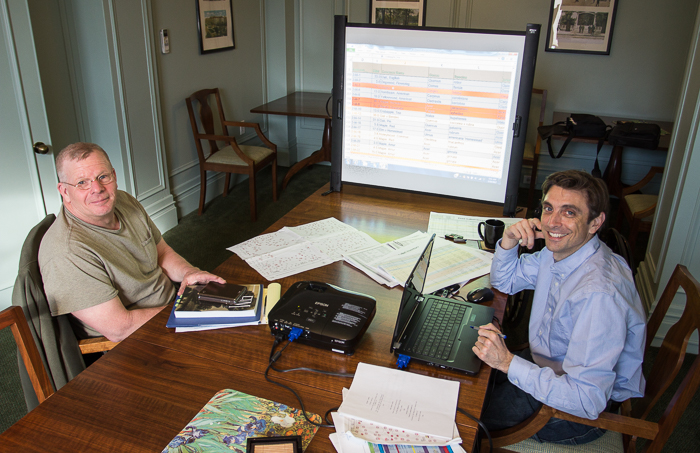These days our parks are quiet, often covered with a blanket of snow, the trees dormant and flowers having long disappeared…is the staff on vacation? Not at all! The winter months are full of activity. Friends Project Manager Bob Mulcahy, Collections Care Manager Sarah Hutt, and consulting arborist and soil scientist Normand Helie are hard at work planning for the year to come, and overseeing winter tree work.

Norm and Bob diving deep into the tree inventory, checking and rechecking!
Sarah and Bob evaluate every piece of sculpture throughout the year, planning out the annual cycle of care and cleaning. Together they prepare the budget, receive proposals from conservators, ready contracts for the proposed work, and notify Boston Parks and Recreation Department, the Boston Arts Commission and Boston Landmarks Commission about upcoming annual maintenance. Once the contracts are signed and paperwork filed, Bob and Sarah will work with the conservator contractors to schedule when the Women’s Memorial, among many, will get the TLC they need.
Another vital winter mission for Bob and Norm is planning for tree and turf care based on observations throughout the spring and summer, working in close collaboration with City Arborist Greg Mosman. Most tree care is planned on a cycle: pruning, fertilization, disease control measures, and as a last resort, removal. But of course, human activity and Mother Nature often have other ideas they can spring on us, and we have to respond to them.
Winter is a time for tree removal as well as pruning, and this year several very special old trees had to be removed from the Common. Despite a valiant fight, an English Elm on the Beacon Street Mall near Walnut Street unfortunately finally succumbed to Dutch elm disease. After the tree was cut down, by evaluating the rings Norm estimates the tree was planted around 1887. The other large, old tree that needs to be cut down is another English elm near the Frog Pond that was severely struck by lightning twice recently. The stress from those strikes weakened the tree enough that it, too, succumbed to Dutch elm disease.
As the Friends begins to do more turf maintenance on the Common and Mall, winter is the perfect time to plan for the upcoming season and assess the challenges of the prior year. What maintenance treatments worked well, what could have worked better, and what areas should be targeted next? Plans for seeding, fertilization, and aerating are developed, all the while keeping an eye out for the unexpected. Always looking to learn, we are planning to visit Central Park in New York City with Greg Mosman to learn about their cultural practices for tree and turf care.
Updating our tree inventory is an on-going winter undertaking. Each park has its own database with information about each tree that can be utilized for future work, track previous work, and even call out which trees are adopted – or could be adopted! (You can think about this for yourselves.) Bob and Norm are collating, checking, and verifying copious amounts of information into a single enormous database. The parks are living places, with trees being pruned, treated for various diseases removed and planted. All of this information is kept on spreadsheets that need to match perfectly in order for the mapping software to work properly. And of course, there are ongoing discussions about the identification of some of the trees; the crabapples are always a challenge. Is the Camperdown elm really a Camperdown, or is it a Horizontallis elm? Are the Bur oaks really Bur oaks? These are a few of the ongoing tree mysteries that are hotly debated around here. Tree labeling is another aspect of our inventory. The labels can get stolen, vandalized or even eaten by squirrels (they love aluminum!), so records always have to reconciled with what is in the parks.
The winter may be the quiet season in our greenspaces but it is a busy time for the Friends, catching up, evaluating, and planning for the quickly approaching green season.

